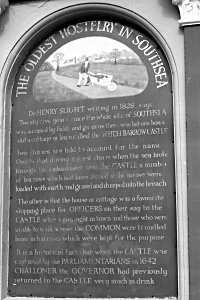Location
Formerly set into the wall of the Wheelbarrow pub, facing Southsea Common.

Dr. HENRY SLIGHT writing in 1828 says
Twenty five years since the whole site of SOUTHSEA
was occupied by field and gardens there was but one house
and a cottage or barn called the WHEELBARROW CASTLE
Two stories are told to account for the name
One is that during a great storm when the sea broke
through the embankment near the CASTLE a number
of barrows which had been stored at the house were
loaded with earth and gravel and dumped into the breach
The other is that the house or cottage was a favourite
stopping place for OFFICERS on their way to the
CASTLE after a gay night in town and those who were
unable to walk across the COMMON were trundled
home in barrows which were kept for the purpose
It is a historical fact that when the CASTLE was
captured by the PARLIAMENTARIANS in 1642
CHALLONER the GOVERNOR had previously
returned to the CASTLE very much in drink
Further Information
Henry Slight was a well known antiquarian active in the early/middle 19th Century whose records (some of which were written together with his brother) form an important part of the documentary history of Portsmouth. He was, however, not well regarded by such luminaries as Sir Frederick Madden who considered his work less than thorough. He also had a penchant for writing his history in verse (See "A Metrical History of Portsmouth", published in 1820).
Slight was however correct in reporting the story of the capture of Southsea Castle by the Parliamentarians in 1642. He may however, have elaborated on the official story of the time which William Gates reports in his book "The Portsmouth That Has Passed". This confirms the alleged drunkeness of the Captain of the Castle, Challiner (sic) on the night in question but does not mention the Wheelbarrow in particular.
Before Southsea Common was drained and the town established, the Wheelbarrow was one of very few buildings on the common. It was not, however, the only hostelry. The other, sited roughly where the Queens Hotel now stands, was the Cricketers and as this was in a direct line from the Wheelbarrow to the castle it seems likely that both hostelries would have been visited by occupants of the castle on a merry night out.
We have no supporting evidence of the first story told by Slight, but given that the Wheelbarrow was several hundred yards from the beach and the route there was across very marshy land, it would have required considerable effort to seal any breach.
[Photo courtesy of Patricia Lovell, c1980]
